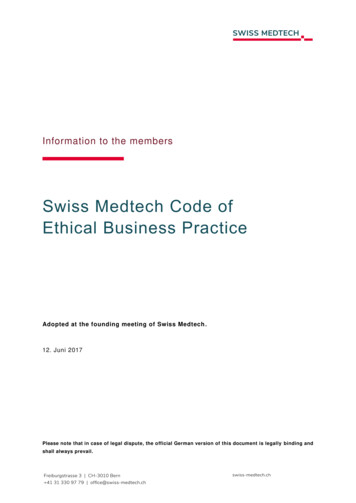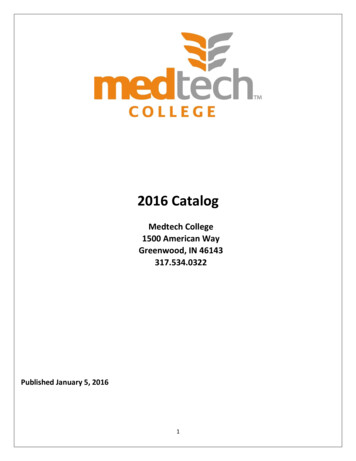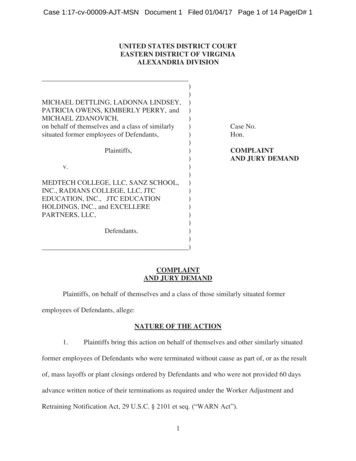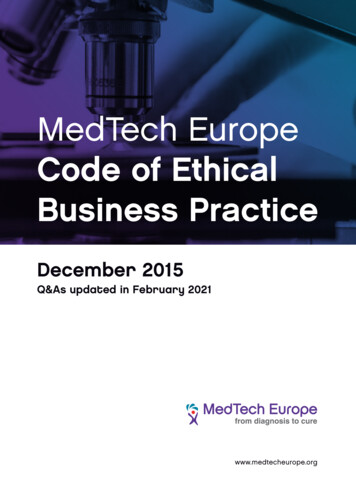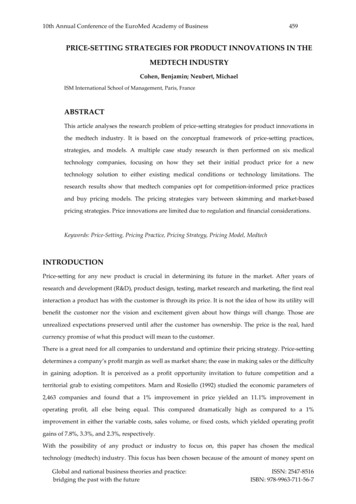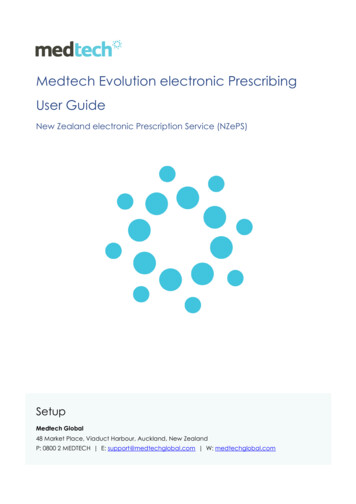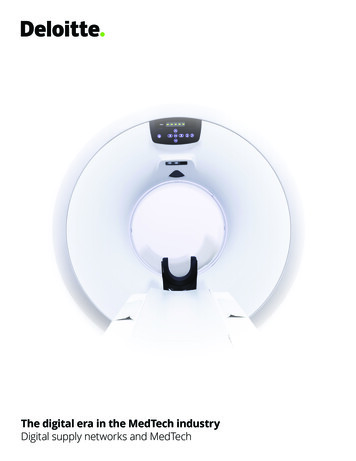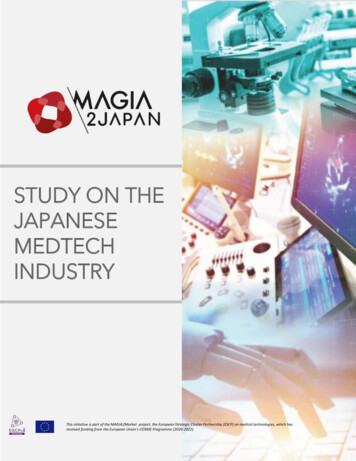
Transcription
STUDY ON THEJAPANESEMEDTECHINDUSTRYMARKETThis initiative is part of the MAGIA2Market project, the European Strategic Cluster Partnership (ESCP) on medical technologies, which hasreceived funding from the European Union’s COSME Programme (2020-2022).
MedTech Alliance for GlobalInternationalisationThis market study and its content is copyright of [the MAGIA – MedTech Alliance for GlobalInternationAlisation project’s team, Lyonbiopole, BioWin, Bioindustry Park Silvano Fumero SpA /bioPmed, Life Science Nord] - [MAGIA project team] [2021]. All rights reserved.Any redistribution or reproduction of part or all of the contents in any form is prohibited other than thefollowing: you may print or download to a local hard disk the study for your personal and noncommercial use only you may copy the content to individual third parties for their personal use, but only if youacknowledge the MAGIA project as the source of the materialYou may not, except with our express written permission, distribute, publish or commercially exploitthe content. Nor may you transmit it or store it in any other website or other form of electronic retrievalsystem.1 Page
Disclaimer“The content of this report represents the views of the author only and is his/her soleresponsibility; it cannot be considered to reflect the views of the EuropeanCommission and/or the Executive Agency for Small and Medium-sized Enterprises(EASME) or any other body of the European Union. The European Commission andthe Agency do not accept any responsibility for use that may be made of theinformation it contains.”2 Page
CHAPTER 1 – EXECUTIVE SUMMARYCHAPTER 2 – INTRODUCTION2.1 – Overview of the Japanese Healthcare and Reimbursement System2.2 – Overview of the potential and specificities of the Japanese Market forMedical technologies2.3 – Japanese MedTech Dynamics2.3.1 – SWOT Analysis2.3.2 – Summary of the Market ForcesCHAPTER 3 – MARKET OVERVIEW3.1 - Revenues3.2 – Trends3.2.1 – Mergers and Acquisitions (M&A)3.2.2 – Shifting Production Overseas3.2.3 – Open Innovation3.3 – Variables3.3.1 – Market segmentation3.3.2 – Key market drivers3.3.2.1 – Government incentives3.3.2.2 – Fuel domestic companies' growth via innovation &collaboration3.3.2.3 – Aging Population3.3.3 – Key Market restraints3.3.3.1 – Regulation3.3.3.2 – Lack of knowledge among the decision-makers3.3.3.3 – Reduction of reimbursement prices3.3.3.4 – Local competition3.4 – Opportunities3.4.1 – Demographic3.4.2 – An efficient and well-organized healthcare system3.4.3 – Regulatory3 Page
CHAPTER 4 – MARKET SEGMENTATION4.1 – Cardiovascular4.1.1 – Market Size4.1.2 – Main Drivers4.1.3 – Main Company Profiles and Products4.1.4 – Competitive Landscape and Opportunities4.2 – Dentistry4.2.1 – Market Size4.2.2 – Main Drivers4.2.3 – Main Company Profiles and Products4.2.4 – Competitive Landscape and Opportunities4.3 – Oncology4.3.1 – Market Size4.3.2 – Main Drivers4.3.3 – Main Company Profiles and Products4.3.4 – Competitive Landscape and Opportunities4.4 – Orthopedics4.4.1 – Market size4.4.2 – Main Drivers4.4.3 – Main Company Profiles and Products4.4.4 – Competitive Landscape and Opportunities4.5 – Chronic Diseases4.5.1 – Market Size4.5.2 – Main Drivers4.5.3 – Main Company Profiles and Products4.5.4 – Competitive Landscape and OpportunitiesCHAPTER 5 – REGULATORY5.1 - Regulatory Landscape5.1.1 – Organization of the Japanese regulatory authorities5.1.2 – MHLW5.1.3 – PMDA5.2 – Medical devices classification5.2.1 – Class I (General Medical Devices)5.2.2 – Class II (Controlled medical devices/designated controlled medicaldevices)4 Page
5.2.3 – Class III / IV5.3 – Medical Devices Registration and Approval Process5.3.1 – Process5.3.1.1. Product registration5.3.1.2. Quality Management System (QMS)5.3.1.3. Software as a standalone medical device5.3.1.4. Summary of the regulatory steps before marketing aproduct in Japan.5.3.2 – Timeline5.3.3 – Fast-Track Review.5.3.4 - Conditionals fast-track reviews.5.3.5 - IDATEN review framework5.3.6 - The Medical Device Single Audit Program5.4 – Medical Devices Pricing and reimbursement ProcessCHAPTER 6 – MARKET ACCESS6.1 – Market Access Overview6.1.1 – Japan Market Specificities (the JIS Standard)6.1.2 – Government Initiatives6.1.3 – The Pharmaceutical and Medical Device Act Regulation6.2 – Import Tariff and consumption tax6.3 – Corporate Structures and Taxes6.3.1 – Representative Office6.3.2 – Branch Office6.3.3 – Subsidiaries6.3.3.1. – Godo Kaisha (G.K.)6.3.3.2 – Kabushiki Kaisha (K.K.)6.3.3.3. Taxes on corporations6.4 – How to succeed in Japan's Medical Device Market6.4.1 – Partnership with a distributor6.4.2 – Subsidiary and maintain control over the product registration.6.5 – Distribution Network6.5.1 – Organization of the distribution network6.5.2 – Main Distributors6.5.2.1 – Century Medical6.5.2.2 – IMI6.5.3 – How to identify and work with a Japanese distributor?5 Page
CHAPTER 7 – JAPANESE HEALTHCARE AGENCIES AND MAIN CLUSTERS7.1 – Governmental Agencies7.1.1 – Organization of the government-business agencies7.1.2 – Ministry of Economic, Trade, and Industry (METI)7.1.3 – Japan External Trade Organization (JETRO)7.1.4 – Agency for Medical Research and Development (AMED)7.2 – Major MedTech Japanese Associations7.2.1. – Medical Technology Association of Japan7.2.2. – Japanese Association of Medical Equipment Industries7.2.3 – The Japan Federation of Medical Associations7.2.4 – Japan Association of Health Industry Distributors7.2.5 – Medical Device Incubation Platform (MEDIC)7.3 – Life-Sciences Clusters in Japan7.3.1 – Kobe Biomedical Innovation Center (KBIC)7.3.2 – InnoHub – Healthcare Innovation Hub7.3.3 – Osaka Bio Headquarters7.3.4 – J-Link7.3.5 – Fuji Pharma Valley Initiative7.3.6 – Life Innovation Platform Yokohama7.3.7 – iPark Shonan7.4 – Academic partnership opportunities7.4.1. RIKEN7.4.2. Other Universities involved in Clinical Medicine and MedicalTechnology7.5 – Funding opportunities for co-development, research, and education7.5.1. Ministry of Education, Culture, Sports, Science, and Technology(MEXT)7.5.2. Japan Society for the Promotion of Science (JSPS)7.5.3. Other Governmental Policy Programs7.6 – Trade Events related to Medical Technologies.CHAPTER 8 – CONCLUSION6 Page
7 Page
CHAPTER 1 – EXECUTIVE SUMMARYWith a well-structured and well-financed Universal Healthcare System, a super-agingpopulation, an appetence for new technology, and a high percentage of imported medical devices,Japan may appear a perfect country to introduce an innovative MedTech device. But thisopportunity does not come without challenges.In 2020, the Japanese MedTech market reached up to 30 US billion, making it the fourth market inthe world. Imported medical devices and technologies accounted for half of the total market, withup to 80% (ophthalmic) of imported devices.The Japanese market does not come without challenges, though. Local regulations should befollowed, leading in some cases to lengthy and costly equivalence studies even though the Japaneseauthorities recently made efforts to streamline the process and homogenize regulations. Amandatory first step is to partner with a local Market Holder Authorization that could be seen insome cases as losing control on the regulatory, distribution, and sale process.The language barrier, time difference, and the medical environment's conservative nature are alsobarriers that may impair foreign companies' entry into the Japanese MedTech space. Hence, theneed to carefully analyze the market, highlight the specific needs and identify Key Opinion Leaders(KOLs) that will be instrumental in promoting a new medical device.The MedTech Japanese ecosystem is well structured, and the Government is active via the use ofgrants promoting collaborative projects with foreign academics or companies. Bioclusters (privateor public) can also be of great help to set foot in Japan and explore the market's potential for aspecific product.Quality of the products is critical when approaching Japan. The country should never be regardedas a test market but a comprehensive international growth strategy.Japan carries many opportunities for MedTech companies, but the hurdles are as high as thepotential rewards. Hence the need to be accompanied by a local partner.8 Page
CHAPTER 2 – INTRODUCTION2.1 – Overview of the Japanese Healthcare and Reimbursement SystemJapan is famous for relying on a universal and costefficient healthcare system. The country achieved universalhealth coverage in 1961 by implementing a mandatory NationalHealth Insurance (NHI) system1. All Japanese citizens must jointhe health insurance scheme according to their employmentstatus and age.Health Policy is multileveled in Japan. It is decided at thenational level, reformulated regionally at the regional level, andimplemented at the municipal level. Although more than 3,500independent insurers exist, they are all integrated into auniform framework that the national governmentmandates. Contrary to the United States, these insurances arenot-for-profit organizations.All enrollees must pay 30 % of the medical bills for children up to 6 (20%) and adults aged 70 – 74with lower incomes (20%), and those aged 75 and older (10%). For catastrophic illnesses withexpenses over a ceiling defined according to the income levels, only 1% is paid as co-payment.When the Japanese Health Insurance system was put in place more than fifty years ago, taxsupported in-home services were predominantly for older adults with low incomes and little familycare. In 1973, the system started to provide free medical care (i.e., no co-payment) for everyoneover 70. However, increasing expenditure for older adults became a significant issue for society, andin 1983, free medical care was ended.To tackle these problems, universal health coverage for long-term care was introduced in 2000under the Long-Term Care Insurance (LTCI) system. The aims of establishing the LTCI system includeshifting the burden of family caregiving to social solidarity, shifting cost-sharing via an insurancepremium system, and integrating long-term care and welfare services.1 https://japanhpn.org/en/section-3-1/9 Page
The Japanese Healthcare system aims to provide high-quality care at a low cost through regulatedfees. In Japan, almost all medical facilities are paid through the social health insurance scheme.Reimbursement is based on the national tariff schedule. In principle, this reimbursement scheduleis revised every two years following negotiation at the Central Social Medical Insurance Council(CSMIC). This council includes representatives from payers' organizations, providers' organizations,and other members representing the public interest from the Ministry of Health and Welfare(MHLW).In terms of access, individuals have free choice over which services they access, and most healthcare is reimbursed on a fee-for-service basis. With few mechanisms to control demand, the primarytool for controlling costs is the provider fee schedule. Review committees in each region monitorclaims and can deny payment for services deemed to be unnecessary.On March 30, 2018, there were 8,389 hospitals (1,400 in France), 101,860 clinics, and 68,756 dentalclinics in Japan (20,000 in France). More than 80% were privately owned. One of Japan's mostpressing health resource utilization problems is its unequal distribution among geographical regionsand sub-specialties. Physicians are free to choose where they will practice, which causes unbalancedspreading within the country.National Health expenditure in Japan is increasing but stays below what we can see in otherdeveloped countries. The figure below presents a comparison of the per capita yearly healthcareexpenditure for France and Japan. Despite having 8% more 65 years old (Percentage of 65 yearsold in 2019: France, 20.8%; Japan: 28%), Japan has lower spending per capita.10 P a g e
The low-cost and high-quality Japanese Healthcare system does not come without challenges andis deemed unsustainable by some Health Economists2. For example, the Japanese visit a doctornearly 14 times a year, more than four times as often as Americans. Very long waiting lines to see adoctor for a couple of minutes of consultation is the norm. Hospitals are overcrowded and oftenrefuse patients brought by paramedics regardless of their condition or situation, leading to dramaticoutcomes in some cases.Japan is the prototype of what a super-aging world will be. In 2025, Japanese baby boomers willturn 75 years old, putting tremendous pressure on the Japanese Healthcare system. In 2042 amaximum will be reached; more than 38 million people will be over 65 years old. More thanstructural reform, Japan aims at using technology to solve some of its over-crowded healthcaresystem problems. Hence, companies can develop innovative medical technology solutions toaddress the Japanese Healthcare system's inevitable issues.2.2 – Overview of the potential and specificities of the Japanese Market forMedical technologiesIn almost all the Asia Pacific Region (APAC) countries, healthcare spending has outpacedGDP growth3 . In 2023, Japan's healthcare spending will reach 721 US billion representing 11.3% ofits GDP. From the 2014-2023 period, Japan's growth in healthcare spending per head (%) is plannedto grow at a 3.9% CAGR (Compound Annual Growth Rate).2 e-Japanese-MedicalPaymentSystem-Sustainable.pdf3 The USD 320 billion healthcare challenge in ean/download?token mxEZJwAOBo11 P a g e
Japan's aging population mainly fuels this growth in healthcare spending. In 2023, Japan's averagelife expectancy is estimated to reach an all-time high of 84.8 years.In 2022, The Japanese Medical technology market isplanned to reach close to US 34 billion in Japan,showing a 4.6% CAGR for the 2018-2022 period 4 , 5making it the fourth in the world after the UnitedStates (US 198 billion) and Germany (US 44 billion).Japan has a robust domestic manufacturing market.Many major Japanese producers, such as Canon,Hitachi, Omron, are very well-known outside Japan.Japan has historically been strong in diagnosticsystems and continues to be a significant globalmarket leader for flexible endoscopes, with a market share of 98%. Japan also holds a global marketshare of 31.9% in MRI systems and 24% in diagnostic imaging equipment.On the other hand, growth has been slow in treatment systems, especially for products like vascularstents. Japanese companies hold only 1.2% of the global market share and artificial joints, whereJapan has virtually no market share.6The following table summarizes the reliance on imports in different segments of the Japanesemedical device market.74 "Worldwide medical device market forecasts," Fitch Solution report5 -medtech-market-size-outlook-by-country/6 pan-2018-117 Development Bank of Japan, Japan Economic Research Institute (2017), JPY 1 CHF 0.0088 (as of October 2018)12 P a g e
Thus, the market for medical devices in Japan relies heavily on imported products. In 2020, importedmedical devices and technologies accounted for 49% of the total market in Japan.In the coming years, the market is expected to remain heavily dependent on imported advancedmedical technologies, mainly due to the high demand for quality products from senior citizens intheir later years of life.There are three important initial steps that foreign companies should take in considering andplanning their Japan market entry:1. Understanding Japanese standards, regulatory approval requirements, and timelines.2. Determining the relative reimbursement pathways and implications for product pricing.3. Finding a distributor to support product launches and ongoing sales and marketing efforts8.When addressing the Japanese market in general and especially for MedTech products, animportant point relates to the need to customize the product to the Japanese market's expectations.8 -market-in-japan/.13 P a g e
Even if the quality is the main adoption driver, a simple "copy-paste" of a product is a sure way tofailure. Japanese consumers are famous for being demanding when it comes to customer support.Language barriers and time differences may constitute hurdles for European companies that willneed to be addressed either by relying on a well-informed and prepared distributor or consideringa local presence.14 P a g e
2.3 – Japanese MedTech Dynamics2.3.1 – SWOT Analysis2.3.2 – Summary of the Market ForcesThe Medical Technology market in Japan carries many potentials and is driven bynumerous positive market forces. The main ones being:- An aging Japanese population.- A well-funded Universal Healthcare system.- A high appetence for new technology.- A mature market and well-established distribution channels.15 P a g e
On the negative side, the regulatory hurdles are somehow high to cross and require a substantialinvestment and time to reach the market. For foreign companies, registering the products via a localdistributor may be a negative point. It may be challenging to switch to another distribution channelonce the approval has been granted.Foreign companies willing to enter Japan will have to assess the potential of the Japanese Marketinitially carefully for the selected product and make sure that the decision to enter Japan is part ofa global and well-funded strategy. The Japanese market can be as challenging as it can be rewarding.It should never be considered as a test market for a new product. The time difference, languagebarrier, specific medical and regulatory ecosystems all contribute to increasing the entry barrier inJapan.Entering Japan requires a thorough knowledge of the competitors and market demands. IdentifyingKey Opinion Leaders (KOLs) that will locally support the medical device is also a critical element toconsider. Japanese Healthcare is conservative by nature, and changes in common practices can onlybe achieved from the inside.16 P a g e
CHAPTER 3 – MARKET OVERVIEWThe global MedTech market is still more fragmented than the biopharma market,although consolidation continues9.3.1 - RevenuesRevenues are divided into Medical devices as a whole and MedTech morespecifically.The overall Japanese medical device market, including MedTech and other equipment, isset to reach from 54.5 billion in 2018 to 74.7 billion in 2025, growing at a compoundannual growth rate (CAGR) of 4.6%, according to GlobalData10.9 portunity-for-japanesecompanies Last accessed 27/01/2110 set-to-reach-74-7-billion-in-2025/17 P a g e
More specifically, the Global MedTech revenues were estimated to reach close to 540billion in 2020, with Japan representing the fourth biggest market with 30 billion in sales11.Japan's aging population and a strong history of adopting new medical technologies havefueled the Japanese market's medical devices growth.While the country has a sizable medical device industry, particularly in imaging technologies,depending on the specific field, up to 80% of Japan's medical devices are imported from theUnited States and Europe 12 . This reliance on imported devices constitutes an excellentopportunity for foreign companies considering they follow the necessary steps andpractices to succeed in Japan.3.2 – Trends3.2.1 – Mergers and Acquisitions (M&A)To pursue their growth and address new markets, Japanese Medical devicescompanies are pursuing an aggressive M&A strategy.The drive toward MedTech by well-known Japanese companies continues; in fact,out of the 20 largest Japanese companies today, over three-quarters of them arealready involved in this business segment. In 2016, Canon's takeover of ToshibaMedical Systems, the fourth-largest diagnostic-imaging player worldwide, is a primeexample of a company expanding in this space in a big way13,14. The acquisition ofHitachi by Mitsubishi Electric's particle therapy business15. Terumo also acquiredthe Chinese Stent company, Essen16.3.2.2 – Shifting Production OverseasTo control production costs, Japan slowly shifted part of its productioncapacities overseas. As in many countries, Sales & Marketing and Managerialdecisions are still made in Japan, part of the production is outsourced. Consequently,working with Japanese medical device manufacturers could open further11 portunity-for-japanesecompanies12 -market-in-japan/.13 ortunity-for-japanesecompanies Last accessed 27/01/2115 tsubishi-Electric-s-particle-therapy-business16 7/235/index.html18 P a g e
opportunities for suppliers and serve as a gateway to other markets, particularly inAsia.With the Covid-19 pandemics, this trend may somehow not be long-lasting, andJapan has already started to switch back to domestic manufacturing to be lessreliant on China173.2.3 – Open InnovationEven though Japan is among the world's largest investors in science andinnovation, domestic corporations were famous for their closed-innovationstrategy, spending close to 3.5% of their GDP. This is changing, partly due tocompanies need to react quickly to technological changes and the increasingimportance of innovation in a deteriorating economic environment.18At the Government level and following the Tohoku earthquake, which enlightenedJapan's need to decrease its self-reliance and open to the world, programs andgrants have been implemented to facilitate global R&D partnerships.Multinationals in Japan are competing with their peers in the U.S., Europe, etc., foremerging international markets such as China. In this situation, the shift of R&Dactivities overseas is inevitable.17 rus-japan-production-a-idUSKBN23F2ZO18 es/asievisions45kmotohashi.pdf19 P a g e
3.3 – Variables3.3.1 – Market segmentationDue mainly to the rapidly aging society, most of MedTech companies'opportunities relate to age-related conditions that act as a magnifier for chronicdisease.The main segments of interests are the followings:- Cardiovascular and surgical implants: Among adults over the age of 20, itis estimated that half have hypertension. Cardiac issues later in life are increasinglycommon. A growing number of U.S. and European companies are getting theircardiovascular devices approved in Japan. A variety of Western companies have alsomarketed advanced stents in Japan over the past several years. Japan has one ofthe largest intravascular imaging markets in the world. Other surgical implantabledevices that meet the needs of the elderly, such as cochlear implants and visioncorrection implants, are also seeing increasing demand in Japan.- Oncology: Cancer is the top cause of mortality in Japan. The mostprevalent cancers are lung and stomach. Japanese cancer treatment centers andhospitals often offer advanced diagnostic and treatment systems like gamma andparticle knife technologies. Western companies' cancer devices are in high demand.- Orthopedics: Knee arthroplasty is estimated to reach more than 20,000procedures every year in Japan and is fueled by the aging population.- Home Care. The Japanese government has implemented specifichealthcare coverage insurances devoted to maintaining the elderly at home for aslong as possible. The Long-Term Care Health Insurance provides benefits in kindsdepending on the level of dependency of the people. Medical technologies allowremote treatments in high demand and will continue to expand in the years to come.It is the same as for Digital Health solutions planned to reach US 2.2 billion in 2025from US 0.7 billion in 2020.The figure below represents the ratio of the different categories of medical devicesused in Japan as of 2020 (Source: Statista).20 P a g e
3.3.2 – Key market drivers3.3.2.1 – Government incentives21 P a g e
Due to government incentives, medical technologies that can allowfor better and more convenient home care—for instance, decentralizedhealthcare delivery or supportive medical robotics—could quickly scale updomestically.Various initiatives have been launched, such as the public-privatepartnership "Realizing the Robot Revolution," which intends to broadeninsurance coverage for robotics in nursing care and expedite the medicalrobots' review process19.In 2018, the Japanese government also started the Future InvestmentStrategy as part of Prime Minister Abe's Society 5.0 vision to create a smartsociety incorporating IoT, big data, and A.I. into industries and daily life.Through this initiative, the Japanese government has created supportnetworks for medical device development, provided clinical trial test sites,and hosted conferences to facilitate a robust R&D environment in theMedTech sector.203.3.2.2 – Fuel domestic companies' growth via innovation & collaborationJapanese Companies interested in growing a MedTech businessneed to innovate their products and their operating model. There are fivekey success factors for companies with an interest to grow in MedTech.These apply to both organic and inorganic growth strategies:1. Drive a targeted and resilient investment strategy.2. Open to innovation models and collaboration opportunities.3. Build critical regulatory and medical capabilities.4. Keep a global perspective from day one.5. Bring existing manufacturing expertise but build competitivemuscle.19 The MedTech opportunity for Japanese Companies. ortunity-for-japanese-companies20 /miraitousi2018 en.pdf22 P a g e
There is a need for Japanese companies to move rapidly. As the globalmedical-device market has tripled in size over the past 20 years, many newinnovative players have entered, and business models have changed andevolved.However, over that same period, the top global players have alsoconsolidated and now generate over half of the worldwide MedTechrevenue.Growth remains the central value-creation lever in MedTech, with a greatdeal of white space available, but the window of opportunity to grow theJapanese economy may close soon due to the decrease in demographicsand increased consolidation between the different players213.3.2.3 – Aging PopulationThe rapidly aging Japanese population, increasing number ofpatients with chronic and lifestyle diseases, universal health insurancecoverage, and regulatory measures drive the Japanese medical devicemarket. Even though the increasing elderly population provides a uniquebusiness opportunity for many international medical device companies toinnovate new products, foreign investment into the untapped Japanesemarket was due to a lack of domestic companies' knowledge22.Japanese physicians are enthusiastic, early adopters of novel medicaltechnologies. Unfortunately, in the past, Japan's onerous regulatoryrequirements meant Japanese physicians were often behind their U.S. andEuropean counterparts in getting access to the latest medical devices.Thus, Japan's medical community has been one of the primary drivers forregulatory reforms that have streamlined the process of getting newmedical devices approved and reimbursed in Japan.Medical device selling prices in Japan are higher, on average, than in othergeographic markets. Historically, Japan has paid the highest prices globally21 portunity-for-japanesecompanies Last accessed 27/01/2122 set-to-reach-74-7-billion-in-2025/23 P a g e
for advanced medical technology, higher than the United States and muchhigher than most European countries.High reimbursement enables many device manufacturers to realize higherproduct prices and profit margins than in many other geographic markets.3.3.3 – Key Market restraints3.3.3.1 – RegulationIn the past, challenging regulatory requirements have led manysmaller medical device companies in the United States and Europe toforego Japan. But Japan has streamlined its regulatory processesconsiderably in the last ten years, including a much greater willingness toaccept foreign data in submissions.The medical device regulatory environment in Japan has been historicallychallenging for foreign companies. In the past, the Pharmaceutical andMedical Device Agency (PMDA) had required foreign medical devicecompanies to conduct local clinical trials. More recently, the PMDA hasbegun to accept foreign clinical data in support of foreign productregistrations.Besides, the regulatory agency has also streamlined the review process andreduced approval times. While still significant, the Pharmaceutical andMedical Device Agency's (PMDA) timeline for approval is significantly lessthan it was just ten years ago.For more complex or novel devices, PMDA may require clinical studies inJapan. While this can be a significant expense, it also creates anopportunity to build relationships with Key Opinion Leaders (KOLs) in Japanahead of a market launch.3.3.3.2 – Lack of knowledge among the decision-makersTwo contradictory facts define the Japanese Healthcare
3 P a g e CHAPTER 1 - EXECUTIVE SUMMARY CHAPTER 2 - INTRODUCTION 2.1 - Overview of the Japanese Healthcare and Reimbursement System 2.2 - Overview of the potential and specificities of the Japanese Market for Medical technologies 2.3 - Japanese MedTech Dynamics 2.3.1 - SWOT Analysis 2.3.2 - Summary of the Market Forces CHAPTER 3 - MARKET OVERVIEW


